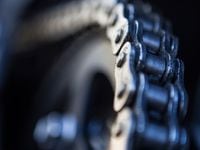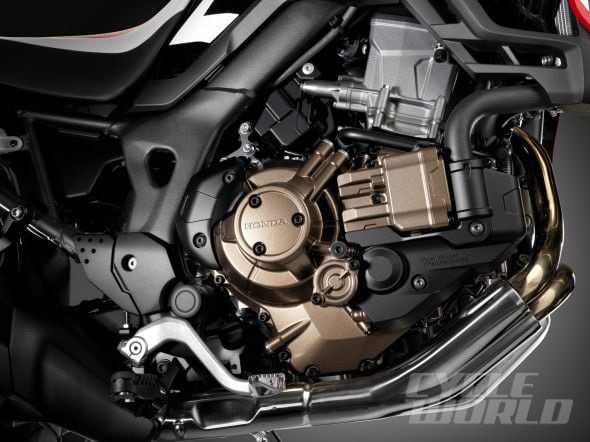QUESTION: I have several Japanese two-strokes (singles, twins, and triples) from the late 1960s and early 1970s and have an issue that has plagued me on countless motorcycles, both new and old, over the decades. And I've never received an explanation that would seem to justify the sheer volume of instances I have run into this issue. So here goes:
Every time I align a chain and front and rear sprockets I find the chain will almost never—and I mean never—run centered over the sprockets. Now, I’ve known for more than 45 years that the little factory indents/alignment marks on the swingarm are generally useless, so I have used all the alignment methods I have ever seen from name-brand alignment tools (that work great by the way) to measure and equalize the distance between the swingarm pivot and the axle shaft to the string method. You name it, and I have tried it!
I always check the sprockets themselves to ensure they are flat as a pancake and not tweaked. Most recently I had a piece of steel machined to be exactly straight and laid it up against the two sprockets of my current project, finding they were misaligned by 1.65mm. I then removed 1.65mm from the countershaft sprocket spacer, as there was more than adequate clearance, and got those two sprockets aligned within a gnat’s behind to no avail. For clarification, the sprockets and chain are new and correct factory OEM parts. The result is always the same: The right inner link of the chain rides up against the right outside edge of the sprocket, thus the chain is slightly to the left of center. Also, for clarification, I always make sure I have the correct play in the chain by measuring it multiple ways, including with the shocks removed and the countershaft, swingarm shaft, and rear axle all in the same plane.
Of course I am also aware that frames and mounting points, etc., were not always perfectly in alignment from the factory 40-plus years ago and can get out of whack from living a hard life over the years. Therefore, I do my best to ensure the frame is not tweaked before I ever start on a project and rectify any problems I find.
So out of curiosity, I recently visited my local multi-brand dealership and nosed around the streetbikes, checking the chain alignment on every brand-new Japanese and Austrian streetbike on the showroom floor. Every single bike I looked at but one (and I looked at 18) had the exact same issue. The chain was to the left of center and riding on the right inner edge. Even the used bikes I looked at had the same issue. The only bikes in the whole dealership that didn’t have the issue were the dirt bikes.
I’ve often wondered if the issue was that the front and rear sprockets were not vertically parallel, and I don’t know how to check that. But after seeing all the new bikes with the exact same issue, well… I give up. Help!
Chuck Floyd
ANSWER: Motorcycles are flexible as compared with the usual industrial machinery on which roller chains might be used. In lower gears, the chain tension can be as high as 2,000 pounds, and this surely deflects both the engine position and the swingarm. Also, in recent times, manufacturers have discovered that bikes have more grip in corners if there is a proper degree of side-to-side chassis flex to take over some of the suspension's job when the bike is leaned over a lot. It is fortunate that chain drive has the ability to tolerate this degree of misalignment.
That being so, a chain drive on the left might be expected to draw the two shafts together (gearbox and rear axle), causing the chain to run a bit to the left.
Ideally we’d like everything to run free, to neither right nor left, but when roadrace teams reached a high point in chassis lateral rigidity around 1993 they realized there was such a thing as too much. Chassis are still very stiff in twist (to keep the two wheels in the same plane), and steering heads strongly resist the bending force of hard braking. But lateral stiffness has been relaxed a bit.
I would only add that the Japanese bikes back then used spindly, unbraced mild steel tubing for frame and swingarm and rubber for swingarm bushings. Guaranteed flex built in. Part of the reason they were so darn exciting.













/cloudfront-us-east-1.images.arcpublishing.com/octane/AUE3NFVRRZDSBIDVUGIYIDQNUI.jpg)
/cloudfront-us-east-1.images.arcpublishing.com/octane/LYR62CH2WNBMHJJVXVATZHOUE4.jpg)
/cloudfront-us-east-1.images.arcpublishing.com/octane/RBCTRGBQYBDK7A6XPG3HKPS7ZQ.jpg)
/cloudfront-us-east-1.images.arcpublishing.com/octane/MQXQRYMZVBCWJIRYP3HEN3SHVE.jpg)
/cloudfront-us-east-1.images.arcpublishing.com/octane/TSPODNNEWRDSVJGUCNQTDG4ADI.jpg)
/cloudfront-us-east-1.images.arcpublishing.com/octane/X5TB7BDV4BA2RPSY54ZGK27RP4.jpg)
/cloudfront-us-east-1.images.arcpublishing.com/octane/REUHOJXRDBGZ5IHBYZCCBCISPA.jpg)
/cloudfront-us-east-1.images.arcpublishing.com/octane/52LGJTCKBFEHDF7S7H4CVUIMGM.jpg)
/cloudfront-us-east-1.images.arcpublishing.com/octane/YMWAIPIPSJAOXOU3QMJMGH37OM.jpg)


/cloudfront-us-east-1.images.arcpublishing.com/octane/EJ6KZRGAYBCVXNL2PJXL37UVWQ.jpg)
/cloudfront-us-east-1.images.arcpublishing.com/octane/AAN4TI76M5H5JMUVEIGASWXBDU.jpg)
/cloudfront-us-east-1.images.arcpublishing.com/octane/P3RXD2UCPFF37CMB7CHPVKXORY.jpg)
/cloudfront-us-east-1.images.arcpublishing.com/octane/VZEG2EJI2RDFZNHLRZMU56MD3Q.jpg)
/cloudfront-us-east-1.images.arcpublishing.com/octane/GVJQO5FFOFBWNGODOBRB4FBAW4.jpg)
/cloudfront-us-east-1.images.arcpublishing.com/octane/BIVAK2SFIBDJJM25E7I5VU2FJE.jpg)
/cloudfront-us-east-1.images.arcpublishing.com/octane/CH5VX52UG5CFHOVH5A6UYEFWWA.jpg)
/cloudfront-us-east-1.images.arcpublishing.com/octane/ZVGJNGZRU5C33N7KN23BBFKSC4.jpg)


/cloudfront-us-east-1.images.arcpublishing.com/octane/CZ5OM3E43ZEXJHY7LCYXCHLIKI.jpg)
/cloudfront-us-east-1.images.arcpublishing.com/octane/DF5T4K5KPZFJXFCTGPYR77PKJM.jpg)
/cloudfront-us-east-1.images.arcpublishing.com/octane/RMCT2KVQBJHBZMRTSLOVPMOILU.jpg)